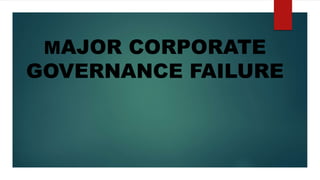
b51b5a400087b29682f63a6a6319ef2f.pptx
- 2. What is corporate governance? Corporate governance is a set of rules, practices and processes used to direct and control a company. It involves balancing the interests of a company’s stakeholders such as management, shareholders, suppliers, customers, financiers, government and the community. Moreover, it is essential for the success and sustainability of the business over a period of time. When the set of rules and processes which form the governance mechanism of a firm are ineffective or fail, it can have disastrous consequences for a business. Several large organisations such Enron, Satyam, Cadbury, Wal-Mart & Xerox were severely impacted due to corporate governance failures.
- 3. Corporate governance failures It doesn’t happen overnight and there are several warning signs which a firm must take note of in order to avoid such failures.Some of the governance issues faced by the firms which eventually lead to corporate governance failures are – Ineffective governance mechanisms, for example, lack of board committees or committees consisting of few or a single member. Non-independent board and audit committee members, for example where a CEO fulfilled multiple roles in various committees
- 4. •Management, who deliberately undermines the role of the various governance structures by circumventing the internal controls and making misrepresentations to auditors and the Board. •Inadequately qualified members, for example,audit committee members not having appropriate accounting and financial qualifications or experience to analyse key business transactions, family members holding board positions without appropriate knowledge or qualifications. •Ignorance by regulators, analysts etc. of the financial results and red flags.
- 5. Corporate governance failures have resulted in massive problems faced by the companies over the years. A couple of examples of corporate governance failures which forced businesses and government authorities to rethink their stance on corporate governance are : ENRON SATYAM
- 6. ENRON The Enron scandal, which broke out in October 2001, eventually led to the bankruptcy of the Enron Corporation, an American energy company based in Houston, Texas. It was the largest bankruptcy reorganization in American history at that time. The primary reason for the failure of Enron was attributed to an audit failure. The problem faced by Enron was despite having structures and mechanisms in place for good corporate governance. Nobody flaunted and flouted these rules and regulations! The board of directors turned a blind eye to open violation of the code. Particularly, when it allowed the CFO to serve in special purpose entities(SPEs). The auditors failed to prevent suspect and questionable accounting. The auditors did not even examine the SPE transactions. Enron shareholders filed a $40 billion lawsuit after the company’s stock price fell. It achieved a high of US$90.75 per share in mid-2000, plummeted to less than $1 by the end of November 2001. On December 2, 2001, Enron filed for bankruptcy under Chapter 11 of the United States Bankruptcy Code.
- 7. AS A RESULT OF THE SCANDAL, THE US GOVERNMENT INTRODUCED NEW REGULATIONS AND LEGISLATION TO EXPAND THE ACCURACY OF FINANCIAL REPORTING FOR PUBLIC COMPANIES. THE SARBANES-OXLEY ACT WAS INTRODUCED AS A RESULT OF THE ENRON SCANDAL. IT INCREASED PENALTIES FOR DESTROYING, ALTERING, OR FABRICATING RECORDS IN FEDERAL INVESTIGATIONS OR FOR ATTEMPTING TO DEFRAUD SHAREHOLDERS. IT ALSO INCREASED THE ACCOUNTABILITY OF AUDIT FIRMS TO REMAIN UNBIASED AND INDEPENDENT OF THEIR CLIENTS.
- 8. SATYAM Satyam began facing problems from December the 16th, 2008. Its chairman Mr Ramalinga Raju, in a surprise move announced a $1.6 billion bid for two Maytas companies. He wanted to deploy the cash available for the benefit of investors. Raju’s family promoted and controlled the two companies. The share prices plunged 55% voicing concern towards Satyam’s poor corporate governance. They overturned the decision in 12 hours. This resulted in the resignation of several independent directors of the firm. Thus, this resulted in a further fall in the share prices of Satyam. On 7th January 2009 B Ramalinga Raju, the founder of Satyam Computer Services, confessed to a Rs 7,000-crore balance sheet fraud . He had hidden it from the IT company’s board, employees and auditors for several years. He revealed in his confession that his attempt to buy Maytas companies was his last attempt to “fill fictitious assets with real ones”.
- 9. THE GOVERNMENT REACTED TO THE FRAUD BY OVERHAULING THE REGULATORY FRAMEWORK.IT INTRODUCED THE NEW COMPANIES ACT 2013, WHICH FIXED LIABILITIES OF AUDITOR AND INDEPENDENT DIRECTORS, AMONG OTHER CHANGES. IN 2014, MARKET REGULATOR SEBI AMENDED CLAUSE 49 OF LISTING GUIDELINES TO IMPROVE CORPORATE GOVERNANCE.
- 10. CONCLUSION Corporate governance is critical issue faced by all companies. The above cases highlight the fact that poor corporate governance can lead to a downfall of the largest companies. Regulatory bodies have increased their scrutiny on the firms are under increased scrutiny by regulatory bodies which increases the importance of good governance. Digital solutions can help firms implement a robust governance mechanism to help significantly reduce risk of governance failure.